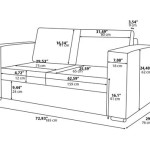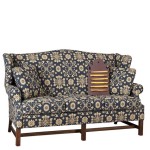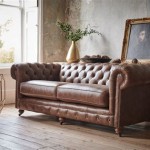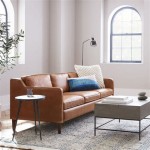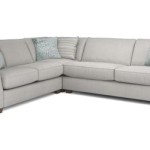What's a Backless Sofa Called? Exploring the Nomenclature and Design of Unsupported Seating
The term "backless sofa" encompasses a range of seating options that, as the name suggests, lack a traditional backrest. While the descriptor is accurate, the specific terminology used to identify such furniture can vary depending on the design, style, and intended use. This article will delve into the different names and classifications associated with backless sofas, exploring their unique characteristics and applications within interior design.
Understanding the nuances of these designations provides a broader appreciation for the versatility and aesthetic potential of backless seating. Beyond simply being "sofas without backs," these pieces often exhibit distinctive features that warrant more precise classifications. Examining these features will clarify common misconceptions and offer a comprehensive overview of the backless sofa landscape.
One crucial aspect in understanding the classification of backless sofas is recognizing their evolution from traditional sofa designs. The absence of a backrest significantly alters the functionality and aesthetic impact of the furniture piece. This difference necessitates specific design considerations, such as cushion stability and the overall proportionality of the seating arrangement.
Furthermore, the use of a backless sofa impacts the spatial dynamics of a room. Unlike traditional sofas that define boundaries and provide a sense of enclosure, backless options often allow for a more open and fluid layout. This characteristic is particularly valuable in smaller spaces, where maintaining a sense of spaciousness is paramount. The following sections will explore the various names and design elements associated with backless sofas.
Daybeds: A Multifunctional Seating and Sleeping Solution
One prominent category that often overlaps with the concept of a backless sofa is the daybed. While not all daybeds are strictly backless, many designs feature either a partial backrest or none at all. Functionally, daybeds serve as both a seating area during the day and a sleeping area at night. This dual purpose makes them a popular choice for guest rooms, studios, and multi-functional living spaces.
Daybeds typically incorporate a frame that resembles a platform bed, often adorned with cushions and pillows to create a comfortable seating experience. Some models include side arms for added support and visual interest, but the traditional backrest is often absent or minimized. The absence of a full back allows daybeds to be positioned against a wall or even floated within a room, offering flexibility in spatial arrangement.
The style of a daybed can range from minimalist and modern to ornate and traditional, depending on the materials and detailing used. Upholstery options are equally diverse, encompassing a wide range of fabrics, colors, and patterns. The aesthetic versatility of the daybed makes it a suitable addition to various interior design schemes. The key distinction from a common understanding of a sofa lies in the daybeds explicit design for occasional sleeping alongside regular seating.
The historical context of the daybed is also relevant. Tracing back to ancient civilizations, daybeds were originally intended as places for rest and relaxation during daylight hours. These early examples often lacked a backrest and were characterized by simple platform designs. The modern daybed retains this fundamental form while incorporating contemporary materials and styling.
The placement of a daybed within a room often dictates its aesthetic impact. When positioned against a wall, it can serve as a stylish alternative to a traditional sofa, while a floating daybed can act as a room divider or a focal point. The use of accessories, such as throw pillows and blankets, further enhances the comfort and visual appeal of the daybed.
Benches: Simple Seating with Diverse Applications
Another category that can be considered a type of backless sofa is the bench. Benches are generally characterized by their elongated, narrow form and lack of a backrest. While often associated with outdoor settings, benches are increasingly used in interior spaces as seating options in entryways, dining areas, and living rooms.
The design of a bench can vary greatly, ranging from simple wooden planks to upholstered models with intricate detailing. Some benches include storage compartments beneath the seating surface, providing added functionality. The versatility of the bench allows it to seamlessly integrate into various design styles, from rustic and farmhouse to contemporary and minimalist.
Unlike traditional sofas that are typically positioned against a wall, benches can be placed in a variety of locations within a room. They can be used to define a seating area, provide additional seating at a dining table, or serve as a decorative accent piece. The lack of a backrest allows for unobstructed views and a more open feel within the space.
The choice of materials plays a crucial role in the overall aesthetic of a bench. Wooden benches offer a natural and rustic appeal, while upholstered benches provide added comfort and sophistication. Metal benches are often associated with industrial or modern design styles. The specific material selection should complement the existing décor of the room.
The size and scale of a bench should also be carefully considered. A small bench can be used as an accent piece in a hallway or entryway, while a larger bench can serve as a primary seating option in a living room. The proportions of the bench should be in harmony with the surrounding furniture and architectural elements.
The integration of benches with other furniture pieces can create a cohesive and functional seating arrangement. For example, a bench can be paired with a coffee table and a couple of armchairs to form a relaxed and inviting living room setting. The versatility of the bench allows for creative and personalized configurations. The functional and aesthetic simplicity of the construction is what typically sets it apart from other types of seating.
Ottomans and Poufs: Versatile Small-Scale Seating Elements
Ottomans and poufs, while not always considered sofas in the traditional sense, can function as backless seating options in informal settings. These pieces are typically characterized by their small size, soft upholstery, and lack of legs. Ottomans are often used as footrests, while poufs can serve as standalone seating or as supplemental seating in a living room.
The design of ottomans and poufs is often playful and eclectic, with a wide range of colors, patterns, and textures available. They can be upholstered in a variety of materials, including leather, velvet, and woven fabrics. The informal nature of these pieces allows for experimentation with bold colors and unconventional designs.
Ottomans and poufs can be easily moved around a room, providing flexibility in seating arrangements. They can be used to create a relaxed and casual atmosphere, particularly in living rooms and family rooms. The lack of a backrest encourages a more informal and interactive seating style.
The size and shape of ottomans and poufs can vary greatly, from small circular designs to larger rectangular models. Some ottomans include storage compartments beneath the seating surface, providing added functionality. The specific size and shape should be chosen based on the intended use and the overall dimensions of the room.
The placement of ottomans and poufs can significantly impact the aesthetic of a space. They can be used as accent pieces to add pops of color and texture, or they can be grouped together to create a more substantial seating area. The versatility of these pieces allows for creative and personalized arrangements.
When selecting ottomans and poufs, it is important to consider the overall style and color palette of the room. These pieces should complement the existing décor and contribute to the overall aesthetic cohesion. The use of coordinating fabrics and patterns can create a unified and harmonious look.
In summary, while the term "backless sofa" might not have a single, universally accepted synonym, the various furniture pieces discussed – daybeds, benches, ottomans, and poufs – represent different iterations of seating that lack a traditional backrest. Each of these options offers unique design characteristics and functional benefits, making them valuable additions to various interior spaces. Understanding the nuances of these classifications allows for a more informed approach to selecting seating solutions that meet specific needs and aesthetic preferences. Identifying the function and intention of the furniture piece is key to selecting the correct terminology, as they each have distinct applications and associated design principles.

Oguta Backless Sofa Skarabrand

Chaise Divan Daybed Settee What S The Difference

Oguta Backless Sofa Skarabrand

How To Choose A Backless Sofa Bench Sofasumo

Chaise Divan Daybed Settee What S The Difference

What S The Difference Between A Chaise Divan Daybed Settee

15 Sofa Styles Diffe Types Of Couches And Sofas

Sectional Sofa Pieces What Do They All Mean The Stated Home Blog

What Is A Divan

25 Types Of Sofas Explained Architectural Digest

